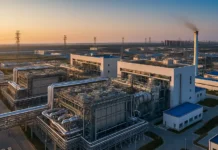AI and Predictive Analytics in Minimising Downtime in Power Plants
The modern power generation landscape demands unprecedented levels of reliability and operational efficiency. As electricity consumption continues growing globally and grid stability becomes increasingly critical, AI and predictive analytics in power plants emerge as transformative technologies that fundamentally reshape maintenance strategies and operational excellence. These advanced systems move beyond traditional reactive maintenance approaches, leveraging sophisticated algorithms and machine learning capabilities to predict equipment failures before they occur.
The financial implications of unplanned downtime in power generation are staggering. Large automotive manufacturing facilities can lose up to $695 million annually from production stoppages, while power plants face similar magnitude losses when critical equipment fails unexpectedly. A single production line shutdown can cost tens of thousands of dollars per hour, making predictive maintenance not just an operational improvement but a critical business imperative.
AI in energy applications have evolved from simple monitoring systems to comprehensive analytical platforms that process vast amounts of operational data in real-time. These systems combine historical performance patterns, current operational conditions, and advanced modeling techniques to provide accurate predictions about equipment health and maintenance requirements. The transformation from reactive to predictive maintenance strategies can reduce equipment failures by up to 70% while extending machinery lifecycles and minimizing emergency maintenance interventions.
The Evolution from Reactive to Predictive Maintenance
Traditional power plant maintenance relied heavily on scheduled interventions based on manufacturer recommendations or reactive responses to equipment failures. These approaches often resulted in unnecessary maintenance activities on healthy equipment or missed early warning signs of developing problems. The introduction of sensor-based condition monitoring systems marked an important advancement, but these early systems frequently generated excessive alarms and false positives that overwhelmed control room operators.
AI and predictive analytics in power plants address these limitations by analyzing comprehensive datasets to identify subtle patterns that indicate developing equipment issues. Machine learning algorithms process multiple data streams simultaneously, including vibration analysis, thermal imaging, acoustic monitoring, and performance trending to create comprehensive equipment health assessments.
The sophisticated modeling approaches employed in modern predictive maintenance include multi-variate anomaly detection models using isolation forests and neural networks such as Long Short-Term Memory (LSTM) and Recurrent Neural Networks (RNNs). These models analyze longitudinal data to identify subtle deviations from normal operational patterns, providing early warning systems that enable proactive interventions.
Advanced Analytics for Equipment Health Monitoring
Modern power plant analytics leverage multiple analytical techniques to assess equipment condition and predict maintenance requirements. Vibration spectrum analysis in rotating equipment like motors, pumps, and turbines can detect bearing defects, misalignment issues, and mechanical wear patterns weeks before complete failure occurs. These systems analyze specific frequency signatures that correspond to different types of mechanical problems, enabling precise diagnosis of developing issues.
Thermal analysis using infrared thermography monitors temperature patterns throughout power generation equipment. Abnormal temperature rises in transformers, electrical switchgear, or mechanical components often indicate developing problems such as electrical resistance increases, lubrication failures, or mechanical friction issues. Predictive maintenance systems can correlate thermal patterns with historical failure modes to provide accurate predictions about remaining equipment life.
Acoustic monitoring techniques analyze sound patterns from rotating machinery, electrical equipment, and process systems. Changes in acoustic signatures often precede visible signs of equipment degradation, providing early warning capabilities that enable maintenance planning before critical failures occur.
Process parameter analysis examines operational characteristics such as pressure differentials, flow rates, efficiency metrics, and power consumption patterns. Artificial intelligence algorithms identify correlations between process parameters and equipment health, enabling predictions based on performance trending rather than just physical condition monitoring.
Machine Learning Applications in Power Generation
Smart energy solutions powered by machine learning algorithms provide sophisticated capabilities for downtime reduction across power generation facilities. These systems learn normal operational patterns for each piece of equipment and continuously compare current performance against established baselines to identify anomalies that may indicate developing problems.
Supervised learning algorithms train on historical maintenance records and failure data to identify patterns that precede equipment failures. These models can predict not only when equipment is likely to fail but also the specific failure modes most probable under current operating conditions.
Unsupervised learning techniques identify unknown patterns in operational data that may indicate previously unrecognized failure mechanisms. These approaches are particularly valuable for detecting rare failure modes or identifying correlations between seemingly unrelated operational parameters.
Deep learning neural networks process complex, multi-dimensional datasets to identify subtle patterns that traditional analytical approaches might miss. These systems excel at recognizing complex interactions between multiple operational variables and equipment performance characteristics.
Real-Time Data Processing and Decision Support
Modern data-driven power systems require real-time processing capabilities that can analyze streaming data from thousands of sensors across power generation facilities. Edge computing architectures enable local processing of critical data streams, reducing latency and ensuring rapid response to developing problems.
Cloud-based analytics platforms provide comprehensive data storage and advanced analytical capabilities that can process historical trends and complex modeling requirements. These systems enable long-term performance trending and sophisticated predictive modeling that requires substantial computational resources.
Integration with plant control systems enables automatic adjustments based on predictive analytics recommendations. These systems can automatically adjust operational parameters to reduce equipment stress when degradation is detected, potentially extending equipment life while maintaining operational performance.
Optimizing Maintenance Scheduling and Resource Allocation
AI-driven production scheduling algorithms dynamically adjust maintenance schedules based on predicted equipment health and operational requirements. These systems can reschedule maintenance activities to minimize operational impact while ensuring equipment reliability.
Condition-based maintenance strategies enabled by artificial intelligence optimize maintenance intervals based on actual equipment condition rather than arbitrary time-based schedules. Studies indicate that condition-based maintenance can extend machinery life by 20% while reducing maintenance costs by 25%.
Resource optimization algorithms ensure that maintenance personnel, spare parts, and specialized equipment are available when needed for predicted maintenance activities. These systems can coordinate complex maintenance schedules across multiple equipment systems to minimize operational disruptions.
Predictive Analytics for Critical Power Generation Equipment
Gas turbine health monitoring represents one of the most sophisticated applications of predictive maintenance in power generation. These systems monitor combustion dynamics, blade condition, bearing health, and thermal patterns to predict maintenance requirements for these critical and expensive components. Advanced analytics can detect early signs of hot gas path component degradation, enabling proactive replacements that prevent catastrophic failures.
Steam turbine monitoring focuses on rotor dynamics, blade integrity, and steam path efficiency. Predictive analytics can identify developing issues such as blade erosion, rotor unbalance, or steam seal degradation that could lead to forced outages if not addressed proactively.
Boiler and heat recovery steam generator monitoring analyzes tube condition, burner performance, and heat transfer efficiency. Machine learning algorithms can predict tube failures, identify optimal cleaning schedules, and optimize combustion parameters to maximize efficiency while minimizing equipment stress.
Electrical system monitoring includes transformer condition assessment, generator health analysis, and power electronics performance trending. These systems can predict electrical component failures and optimize maintenance schedules to prevent unplanned outages.
Integration with Smart Grid Technologies
Smart power systems require flexible power generation capabilities that can respond rapidly to grid demands and renewable energy fluctuations. Predictive analytics enable power plants to operate as reliable grid resources by ensuring equipment availability when needed most.
Grid frequency regulation services benefit from predictive maintenance systems that ensure generating units can respond reliably to automatic generation control signals. These systems predict equipment availability and performance capabilities, enabling grid operators to dispatch resources with confidence.
Renewable energy integration support requires flexible backup generation that can start quickly and operate reliably during periods of low renewable output. Predictive maintenance ensures that backup generating units remain available and can respond when needed.
Economic Benefits and Performance Improvements
The financial benefits of implementing AI and predictive analytics in power plants extend across multiple operational areas. Reduced maintenance costs through optimized scheduling and condition-based interventions can decrease total maintenance expenditures by 15-30% while improving equipment reliability.
Improved plant availability factors result from reduced unplanned outages and optimized maintenance scheduling. Even modest improvements in availability can generate substantial revenue increases for power generation facilities operating in competitive electricity markets.
Extended equipment lifecycles through optimized operating conditions and proactive maintenance can defer major capital expenditures while maximizing return on existing asset investments. Predictive analytics help operators avoid operating conditions that accelerate equipment degradation.
Enhanced safety performance results from proactive identification of equipment problems before they can create hazardous conditions. Predictive maintenance systems can identify potential safety risks and enable corrective actions before dangerous situations develop.
Implementation Strategies and Best Practices
Successful implementation of predictive maintenance systems requires careful planning and systematic deployment approaches. Organizations should begin with pilot programs focused on critical equipment systems that have the highest impact on plant reliability and operational costs.
Data quality and sensor reliability represent crucial success factors for predictive analytics implementation. High-quality, calibrated sensors provide the accurate data necessary for effective machine learning algorithms and reliable predictions.
Staff training and change management ensure that operations and maintenance personnel can effectively utilize predictive analytics capabilities. Training programs should emphasize how predictive insights complement traditional maintenance expertise rather than replace human judgment.
Integration with existing maintenance management systems enables seamless workflow integration and ensures that predictive recommendations translate into actionable maintenance activities.
Advanced Applications and Emerging Technologies
Artificial intelligence continues advancing toward more sophisticated capabilities in power generation applications. Digital twin integration combines predictive analytics with comprehensive system modeling to provide even more accurate predictions and optimization recommendations.
Autonomous maintenance systems represent the next evolution in predictive maintenance, with artificial intelligence making automatic operational adjustments to extend equipment life and optimize performance without human intervention.
Enhanced sensor technologies including wireless monitoring systems, advanced materials sensors, and non-intrusive monitoring techniques expand the scope and accuracy of predictive analytics capabilities.
Cybersecurity and Data Protection
Smart energy solutions require robust cybersecurity frameworks to protect critical operational data and predictive analytics systems. Advanced threat detection systems monitor for unusual network activity that could indicate cyberattacks on predictive maintenance infrastructure.
Data encryption and secure communication protocols ensure that operational data remains protected during transmission and storage. These measures are essential for maintaining the integrity of predictive analytics systems in critical infrastructure applications.
Future Developments and Industry Trends
The evolution of AI in energy continues toward even more sophisticated applications that will further enhance downtime reduction capabilities. Advanced machine learning techniques including reinforcement learning and federated learning will enable more accurate predictions while protecting sensitive operational data.
Integration with Internet of Things (IoT) technologies will expand the scope of predictive maintenance monitoring to include previously unmonitored equipment and systems. These expanded monitoring capabilities will provide more comprehensive equipment health assessments.
Cloud-based analytics platforms will continue advancing to provide more powerful computational capabilities and enhanced collaboration tools that enable predictive maintenance insights to be shared across multiple facilities and organizations.
AI and predictive analytics in power plants represent fundamental advances in power generation reliability and operational efficiency. As electricity demands continue growing and grid stability becomes increasingly important, these technologies will become essential for competitive power generation operations. The combination of reduced downtime, optimized maintenance costs, and enhanced equipment reliability positions predictive analytics as a cornerstone technology for the future of power generation excellence.
Key Takeaways:
- AI-driven predictive maintenance reduces equipment failures by up to 70%
- Condition-based maintenance extends machinery life by 20% while reducing costs by 25%
- Multi-variate anomaly detection identifies subtle equipment degradation patterns
- Real-time analytics enable proactive interventions before critical failures occur
- Integration with smart grid systems enhances reliability and grid service capabilities




































